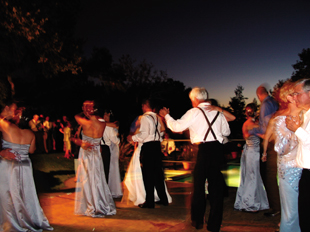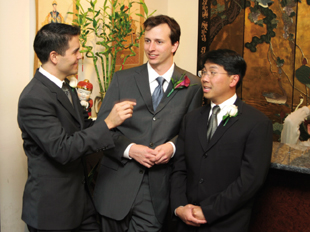Hack 31 Capture the Nighttime Mood and Leave the Red Eye at Home
| < Day Day Up > |
| Shooting with flash indoors against a dark, boring background often produces overexposed subjects with red eye. But it doesn't have to be that way . Built-in camera flashes are very convenient . But they can produce deadly results when used to take pictures of people in low-light situations, such as evening parties. Aside from the plague of red eye that turns your loved ones into otherworldly demons, there's also the nuclear look where the subject appears to be standing next to ground zero, glowing beyond recognition. It doesn't have to be that way. The easiest way to increase your success rate is to get an external flash; it's just easier to control the lighting that way. But for many people, that's not practical. So, in this hack we'll look at the options for the portable digicam, then talk about more advanced techniques with external flash. Let's start with taming the pocketable point and shoot. 3.4.1 Pocketable Party ShotsThe people who design compact digicams realize that these cameras don't always produce great flash results at night. So, many of today's models have features designed to help you get better shots in these challenging situations. Some of these features work better than others. Here's a quick overview of what to look for and what to avoid:
Figure 3-4. Slow Synchro Flash mode
To sum up these options, I'd say avoid Red Eye Reduction mode altogether. Try Nighttime Flash mode when you want to get artistic shots that show activity through blurred movement. Use flash exposure compensation in combination with any of the other techniques to adjust the amount of light your flash is producing. And, if your camera has Shutter Priority mode, start there with an ISO setting of 200. 3.4.2 Advanced TechniquesFor cameras with hot shoes that accept dedicated external flashes, there are more options available. The two most important ones are bounce flash and flash on a bracket :
As you may have guessed, there are a few tricks involved with using either of these advanced techniques, especially bounce flash. The first matter of concern is the surface off of which you're bouncing light, usually a ceiling. This technique doesn't work well if the ceilings are too high. Ceilings that are 8 to 12 feet high are perfect. The higher the ceiling, the more powerful flash you need, because of the increased distance the light has to travel. Also, the color of the surface is important. As you may have guessed, white is best, because it's highly reflective and doesn't add a color cast to the light. Off-whites are okay, but they're not as reflective. Colored ceilings usually won't work; they absorb too much light and add a funky color cast to the scene. Figure 3-5 is a good example of using bounce flash with a white ceiling that isn't too high. This technique produces natural-looking skin tones and avoids red eye. Notice a little bit of blurring in the left subject's hand as he motions . That's a result of quick movement combined with a slow shutter speed (1/15 of a second), which was used to preserve the ambient lighting. Figure 3-5. Bounce flash with a low ceiling An old newspaper photographer's trick is to rubber- band a business card to the flash head, making a little reflector. By doing so, you not only bounce light off the ceiling, but you also get a little kick light aimed directly at the subject's eyes. This adds twinkle and helps prevent the eye sockets from getting too dark. Since you lose light when you use the bounce technique, use your most powerful flash and increase the ISO setting to 200 or 400. Check your pictures on the camera's LCD monitor to make sure they're not underexposed (too dark). I like to shoot bounce flash in Shutter Priority mode at 1/15 or 1/30 of a second. The backgrounds usually look much better at those settings. For serious party shooting, such as wedding receptions, get a bracket that raises your flash above the camera lens. You'll need a dedicated flash cord to use this technique, and be warned : camera manufacturers usually charge US$50 or more for these accessories. Once you have your flash mounted on a bracket, you can use any of the techniques outlined in this section, plus direct flash, and never have to worry about red eye or unsightly shadows again. |
| < Day Day Up > |
EAN: 2147483647
Pages: 161